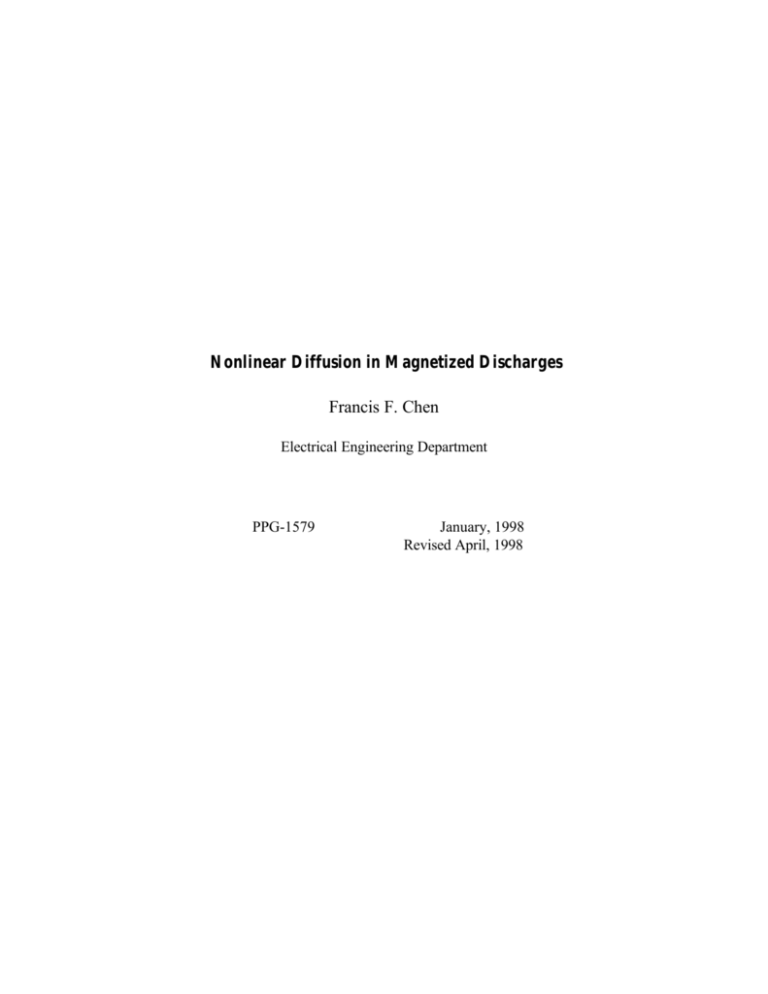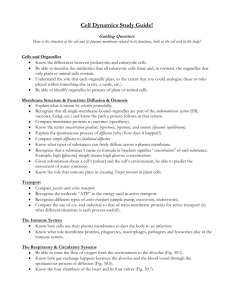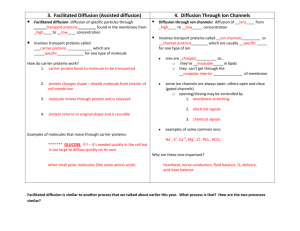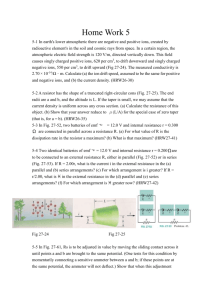Nonlinear Diffusion in Magnetized Discharges Francis F. Chen
advertisement

Nonlinear Diffusion in Magnetized Discharges Francis F. Chen Electrical Engineering Department PPG-1579 January, 1998 Revised April, 1998 Nonlinear Diffusion in Magnetized Discharges Francis F. Chen Electrical Engineering Department, University of California, Los Angeles, California 90095-1594 ABSTRACT In high-density gas discharges in which the electrons, but not the ions, are confined by a magnetic field, the radial density profile is often observed to have a triangular shape, as if the ionization were concentrated on axis. However, such profiles can also result from nonlinear diffusion, in which the diffusion coefficient varies inversely with density. I. INTRODUCTION Magnetically enhanced inductive discharges are often used to produce high density plasmas for industrial purposes. Research on helicon discharges in uniform cylinders, for instance, is being pursued in many laboratories in order to study the behavior of partially ionized plasmas with a DC magnetic field capable of confining the electrons but not strong enough to confine the ions. In such discharges, the radial density profile is sometimes observed to have a triangular shape [1]. A recent example of such a profile is shown in Fig. 1 [2]. If radial diffusion is controlled by diffusion in a background of neutrals, one would expect a convex density profile; for instance, a J0 Bessel function if the ionization is proportional to electron density [3]. A concave or straight profile would suggest that ionization is heavily concentrated on axis, in contradiction to theoretical results on the coupling of helicon waves to TrivelpieceGould modes near the surface [4]. In this paper we explore the possibility that these strange profiles are caused by an unusual classical diffusion mechanism. II. DIFFUSION IN INTERMEDIATE MAGNETIC FIELDS Consider an infinitely long plasma column confined in a tube of radius a with a coaxial DC magnetic field B0 of 50-1500 G magnitude. In this field, electrons will usually have Larmor radii rL much smaller than a, but heavy ions, such as argon, will have rL >> a. Ions will diffuse radially outward, impeded by collisions with the neutral gas; but they will also be impeded by collisions with electrons, since the electrons are restrained by the magnetic field and cannot easily move radially with the ions. The physical picture is that the slowly drifting ions are continuously bombarded by electrons moving along B0 z$ . The momentum exchange is mostly in the z direction, but the small amount of radial momentum that the ions lose to the electron “rods” is what impedes ion loss. In principle, there should be an ambipolar electric field slowing the radial ion motion, but in practice such fields are not usually observed. Radial variations in potential tend to be weak and of the wrong sign to give an ambipolar field [5]. Fig. 2 shows a radial profile of plasma potential obtained from the inflection point of the I-V characteristic of a fully RF-compensated Langmuir probe [2]. The plasma potential does not follow the density variation, and the radial E-field is too weak to affect the ion motions. The absence of an inward pointing E-field is expected only if axial transport can be neglected, as in very long discharges. In the opposite limit of isotropic diffusion, one would expect the electrons to thermalize into a Boltzmann distribution ne = n0 exp(eV/KTe), so that the potential follows the density profile and the E-field points outwards. In the intermediate case of magnetized discharges of finite length, the short-circuit effect comes into play. In this 2 mechanism, the sheath drop on the end wall terminating each magnetic field line can adjust itself to bleed off excess electrons on that field line (or to cure a deficit of electrons by erecting a higher Coulomb barrier) so as to maintain a self-consistent radial E-field. Though a detailed calculation is almost impossible because electron motions can also be affected by highfrequency instabilities, the result can be the near-elimination of the radial E-field, as is observed. We therefore neglect the radial electric field from now on and consider the diffusion of ions in a background of neutrals and “stiff” electrons. The total ion collision frequency is given by ν = ν ie + ν in + ν ii , (1) where the last term represents ion-ion collisions, which can safely be neglected since there is no shear flow. The singly ionized ion-electron collision frequency νie is given by Book [6] as ν ie = 16 . × 10−9 ne ln Λ / Ai Te1/ 2 Ei , (2) where Ai is the ion mass number, Te is the electron temperature in eV, Ei is the ion energy, and the Coulomb logarithm lnΛ for these plasma is about 10.7. For a Maxwellian ion distribution, we may approximate Ei by (3/2)Ti. The ion-neutral collision frequency νin is dominated by charge exchange, the cross section for which is given for low energies by Sheldon [7]. Since this was found to agree with mobility data, we can also infer νin from the measured mobility of Ar+ in Ar, namely, 1.5 cm2/V-sec at 760 Torr and 296°K [8]. This yields ν in = 2.05 × 104 po ( mTorr ) . (3) The critical density above which ion-electron collisions are dominant over ion-neutral collisions is therefore given by p0 ncrit = 2.05 × 104 . (4) ν ie / ne For Te = 3 eV and Ti = 0.0257 eV in argon, this gives ncrit ≈ 1013 cm-3, a rather high value even with room temperature ions. However, at these densities the neutral pressure inside the plasma is reduced by the ion-pumping effect, which was inferred by Sudit and Chen [5] and has since been confirmed by direct measurement [9]. To estimate the ion pumping effect, consider a plasma of radius a and length L, so that the volume V is V = πa2L. Initially, gas is bled in at a flux Γin atoms/sec and pumped out at a rate S cm3/sec, resulting in a fill pressure po (mTorr) and a neutral density nn0 = p0N0, where N0 = 3.3 × 1013 cm-3 at 300°K. After the discharge is struck, the neutrals inside the plasma are ionized, and ions with an average density ni are accelerated by the pre-sheath electric field toward the pump at one end of the discharge tube. We assume that the pump manifold is large enough to remove the recombining ions without appreciable refluxing of the neutrals, and we neglect the transit time of the accelerated ions. Next, we compute the neutral density nn1 in the chamber when the plasma is on. The flux of atoms leaving the plasma at both ends is dNi/dt = -2πa2⋅½nics, where cs is the ion sound speed (KTe/M)1/2 and ½ni is the ion density at the sheath edge . Ions are created at the rate dNi/dt = πa2Lnenn1Pi where Pi ≡ <σv>ion is the ionization probability, a sensitive function of Te. Equating this to the loss rate, we find that ne = ni = n cancels, and nn1 is given by nn1 = cs / LPi . 3 (5) If Γin is not measured, we can find nn0 as follows. Neutrals are lost at the rate that ions are lost at the pump end of the tube: Γ out = πa 2 ½ ni cs . (6) Equating this to Γin = Snn0, we have nn 0 = πa 2 ½ni cs / S . (7) The pressure reduction ratio is therefore given by Eqs. (5) and (7) as ε≡ nn1 2S = . nn 0 Vne Pi (8) Since the diffusion coefficient for unmagnetized particles is given by D = KT/Mν, Eq. (2) leads to Die = 8.4 × 1019 Te½ Ti 2 / ne , (9) while Eq. (3) gives (for argon) Din = 12 . × 106 Ti / p0 . (10) Substituting εp0 for p0 in Eq. (10) and solving for ne, we obtain ncrit = (14 . × 1017 Te½ Ti S / VPi )1/ 2 . (11) For instance, for Te = 3 eV, Ti = 0.1 eV (assuming some heating by the electrons), S = 105 cm3/sec, and a = 5 cm, ncrit is 1.2 × 1012 cm-3. As Te ranges from 2 to 5 eV, ncrit changes from 5 ×1012 to 4 × 1011 cm-3, densities usually well exceeded in the experiments in question. We may therefore neglect diffusion via ion-neutral collisions. III. RADIAL PROFILES In the previous section we have tried to justify the neglect of νin; we now explore the consequences if this approximation is reasonable. With the use of Eq. (2) the ion diffusion coefficient is given by KTi A D= ≡ , (12) Mν ie n where the constant A is of order 1017 cm-1sec-1 (argon, Ti = 0.0257 eV, Te = 3 eV). Thus, D varies as 1/n, rather than as n, as for perpendicular diffusion of a fully ionized and fully magnetized plasma [3]. The steady-state equation of continuity is ∇ ⋅ ( D∇n) + Q = 0 . (13) Neglecting longitudinal ion diffusion in a long, thin cylinder, we have FG H IJ K A d r dn +Q = 0. r dr n dr (14) 4 1. Case of Q = constant If the source term is uniform, the finite solution of Eq. (9) is ln n = C − Q 2 r . 4A (15) If we apply the boundary conditions n = n0 at r = 0, n = δn0 at r = a, the density profile depends only on the edge density and is given by 2 2 n = δ r /a . n0 (16) Fig. 3 shows such profiles for several values of δ. Though these Gaussians are closer to Fig. 1 than Bessel functions, they are still not sufficiently “triangular.” Uniform ionization can apply, for instance to discharges ionized by ultraviolet light or fast electron beams, such as in E-beam excited CO2 lasers. 2. Case of Q proportional to n The ionization frequency per unit volume is given by Q = nn ne < σv >ion ≡ Gne , (17) where the ionization probability <σv>ion is sensitive to Te. Eq. (9) now becomes FG H IJ K d r dn G = − nr . dr n dr A (18) Changing to dimensionless variables n* = n/n0, r* = r/a, and (′) = a(d/dr); defining q ≡ Gn0a 2 / A ; and then dropping the (*), we obtain n ′′ + FG 1 − n′ IJ n′ + qn Hr nK (19) 2 = 0. (20) Values of q for various temperatures and densities are shown in Fig. 4, and numerical solutions of Eq. (20) for various values of q are shown in Fig. 5. These density profiles are “triangular” only for intermediate values of q. The curve for q = 10 resembles not only Fig. 1 but also profiles measured by L. Porte [10] in an entirely different machine: 2.5-cm radius, 20 mTorr, and 800G, with Te = 3 eV and peak density ≈3 × 1013 cm-3, parameters for which q = 10 is appropriate. 3. Case of bimodal energy deposition Numerical computations of energy deposition by coupled helicon and TrivelpieceGould (TG) waves [4] usually show two peaks, one near the surface due to TG absorption, and one near the axis due to helicon absorption. An example of such a bimodal energy deposition profile is shown in Fig. 6, calculated for a high-field discharge11. Local deposition of RF energy raises Te locally and increases <σv>ion, and hence q there. We have modeled this situation by using a function q(r) consisting of two Gaussians centered at different radii. An ex- 5 ample is shown in Fig. 7, where it is seen that the resulting profile n(r) is “triangular,” resembling the measured data shown in Fig. 1 and reproduced in Fig. 7. IV. Summary Transverse diffusion of fully ionized plasmas in intermediate magnetic fields is shown to be governed by a diffusion coefficient inversely proportional to the density. The assumption of complete ionization is valid over a density range applicable to high-density plasma sources if the ion pumping effect is taken into account. This nonlinear diffusion, coupled with a physically reasonable RF absorption profile, can lead to the triangular density profiles observed experimentally in helicon discharges. 6 REFERENCES 1. G. Chevalier and F.F. Chen, J. Vac. Sci. Technol. A 11, 1165 (1993). 2. D.D. Blackwell, Master’s Thesis, UCLA (1994). The data shown were taken more recently in the same machine. 3. F.F. Chen, Introduction to Plasma Physics and Controlled Fusion, 2nd ed., Vol. 1, Chap 5 (Plenum Press, New York). 4. D. Arnush and F.F. Chen, Phys. Plasmas 5, xxxx (1998). 5. I.D. Sudit and F.F. Chen, Plasma Sources Sci. Technol. 5, 43 (1996), Fig. 10. 6. D.L. Book, NRL Plasma Formulary, Publication 0084-4040, Naval Research Laboratory, Washington, DC 20375-5320. 7. J.W. Sheldon, Phys. Rev. Lett. 8, 64 (1962). 8. E.W. McDaniel and E.A. Mason, Mobility and Diffusion of Ions in Gases (Wiley, New York, 1973), p. 274. 9. J. Gilland and N. Hershkowitz, Bull. Amer. Phys. Soc. 42, 1751 (1997). 10. L. Porte, Bull. Amer. Phys. Soc. 42, 1818 (1997). 11. D. Arnush and F.F. Chen, UCLA Report PPG-1573 (1997). FIGURE CAPTIONS 1. Typical “triangular” density profile, with a = 5 cm, B0 = 640G, p0 = 3 mTorr of argon, Prf = 1 kW at 13.56 MHz [2]. 2. Radial profiles of density, space potential Vs, and floating potential Vf for a 10-cm diam discharge at 600 G, 6 mTorr, and 1.5 kW at 13.56 MHz [2]. 3. Computed density profiles for uniform ionization. 4. Dependence of the dimensionless parameter q on density and temperature, for Ti = 0.05 eV, p0 = 3 mTorr, a = 5 cm. 5. Computed density profiles for ionization proportional to density. The curves are in the same order as in the legend. 6. Plasma loading as a function of radius, computed for a half-wavelength m = +1 helical antenna and a triangular density profile. Other parameters were: B0 = 1 kG, n = 1013 cm3 , p0 = 3 mTorr of argon, and f = 27.12 MHz [11]. 7. Density profile computed for a spatially varying source of plasma heating, as shown by the broad line. The points are the data of Fig. 1. 7 2.5 1.5 13 -3 n (10 cm ) 2.0 1.0 0.5 0.0 -5 -4 -3 -2 -1 0 1 2 3 4 r (cm) 1.0 40 0.8 -3 50 cm ) 1.2 13 60 30 0.6 Vs Vf n13 20 0.4 10 0.2 0 0.0 0.0 0.2 0.4 0.6 r/a Fig. 2 0.8 1.0 Density (10 Potential (V) Fig. 1 8 1.0 n /n0 (edge) n / no 0.8 0.3 0.2 0.1 0.05 0.6 0.4 0.2 0.0 0.0 0.2 0.4 0.6 0.8 1.0 r/a Fig. 3 1000 Te (eV) 100 5 4 3 q 2 10 1 0 1E+11 1E+12 -3 no (cm ) Fig. 4 1E+13 1E+14 9 1.0 q n / no 0.3 1 3 10 30 100 300 1000 0.0 0.0 1.0 r/a Fig. 5 125 HH(1,1,1) P(r,m) (kΩ/m2) 100 75 50 25 a = 2 cm a = 3 cm 0 0 0.01 0.02 r (m) Fig. 6 0.03 10 1.0 n / no 0.8 0.6 0.4 heat source 0.2 0.0 0.0 0.2 0.4 0.6 r/a Fig. 7 0.8 1.0 1.2






